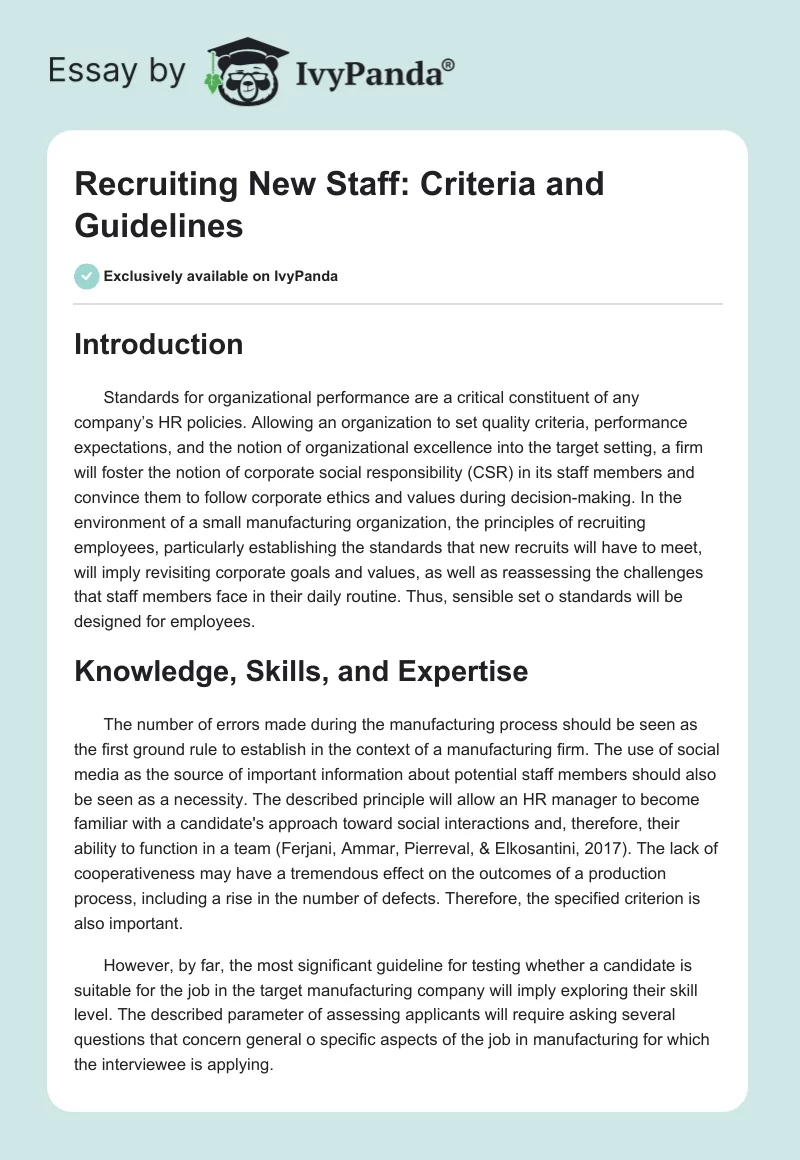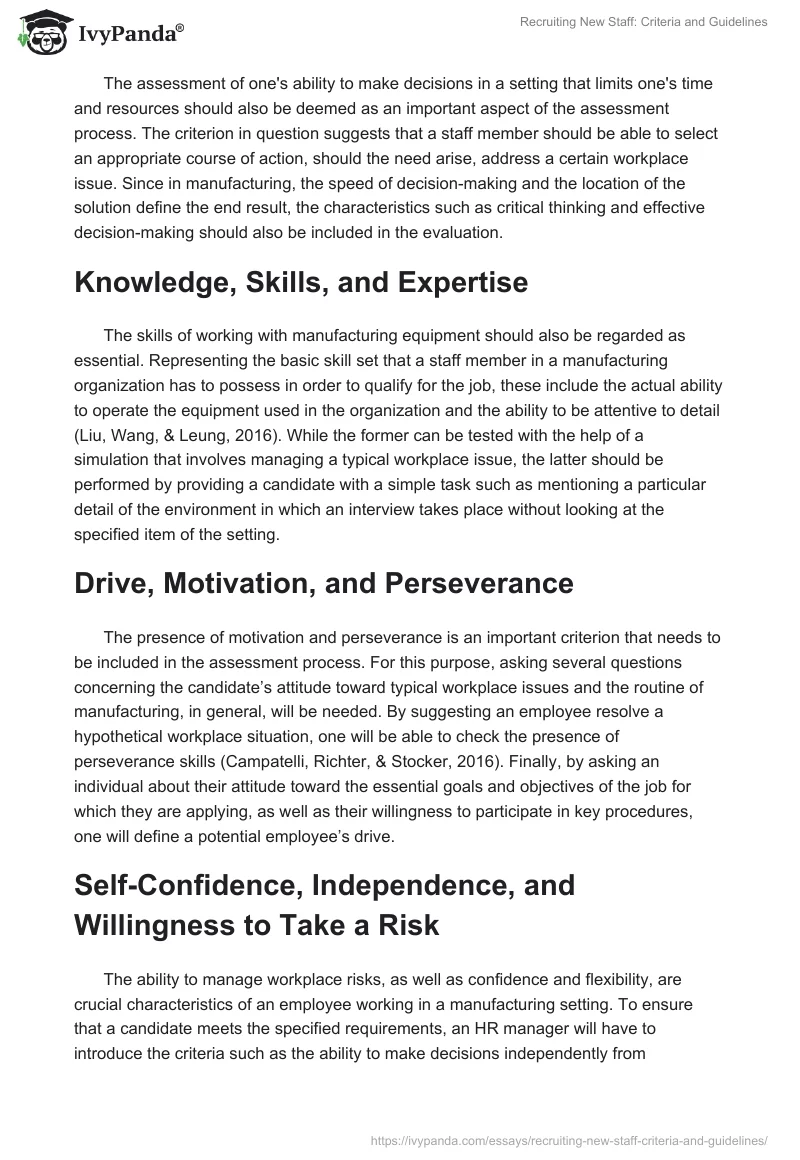Introduction
Standards for organizational performance are a critical constituent of any company’s HR policies. Allowing an organization to set quality criteria, performance expectations, and the notion of organizational excellence into the target setting, a firm will foster the notion of corporate social responsibility (CSR) in its staff members and convince them to follow corporate ethics and values during decision-making. In the environment of a small manufacturing organization, the principles of recruiting employees, particularly establishing the standards that new recruits will have to meet, will imply revisiting corporate goals and values, as well as reassessing the challenges that staff members face in their daily routine. Thus, sensible set of standards will be designed for employees.
Knowledge, Skills, and Expertise
The number of errors made during the manufacturing process should be seen as the first ground rule to establish in the context of a manufacturing firm. The use of social media as the source of important information about potential staff members should also be seen as a necessity. The described principle will allow an HR manager to become familiar with a candidate’s approach toward social interactions and, therefore, their ability to function in a team (Ferjani, Ammar, Pierreval, & Elkosantini, 2017). The lack of cooperativeness may have a tremendous effect on the outcomes of a production process, including a rise in the number of defects. Therefore, the specified criterion is also important.
However, by far, the most significant guideline for testing whether a candidate is suitable for the job in the target manufacturing company will imply exploring their skill level. The described parameter of assessing applicants will require asking several questions that concern general o specific aspects of the job in manufacturing for which the interviewee is applying.
The assessment of one’s ability to make decisions in a setting that limits one’s time and resources should also be deemed as an important aspect of the assessment process. The criterion in question suggests that a staff member should be able to select an appropriate course of action, should the need arise, address a certain workplace issue. Since in manufacturing, the speed of decision-making and the location of the solution define the end result, the characteristics such as critical thinking and effective decision-making should also be included in the evaluation.
The skills of working with manufacturing equipment should also be regarded as essential. Representing the basic skill set that a staff member in a manufacturing organization has to possess in order to qualify for the job, these include the actual ability to operate the equipment used in the organization and the ability to be attentive to detail (Liu, Wang, & Leung, 2016). While the former can be tested with the help of a simulation that involves managing a typical workplace issue, the latter should be performed by providing a candidate with a simple task such as mentioning a particular detail of the environment in which an interview takes place without looking at the specified item of the setting.
Drive, Motivation, and Perseverance
The presence of motivation and perseverance is an important criterion that needs to be included in the assessment process. For this purpose, asking several questions concerning the candidate’s attitude toward typical workplace issues and the routine of manufacturing, in general, will be needed. By suggesting an employee resolve a hypothetical workplace situation, one will be able to check the presence of perseverance skills (Campatelli, Richter, & Stocker, 2016). Finally, by asking an individual about their attitude toward the essential goals and objectives of the job for which they are applying, as well as their willingness to participate in key procedures, one will define a potential employee’s drive.
Self-Confidence, Independence, and Willingness to Take a Risk
The ability to manage workplace risks, as well as confidence and flexibility, are crucial characteristics of an employee working in a manufacturing setting. To ensure that a candidate meets the specified requirements, an HR manager will have to introduce the criteria such as the ability to make decisions independently from managers and the presence of strong certainty in one’s selected course of actions even in the presence of the opposite opinion voiced by an authority (Håkansson & Isidorsson, 2015). Similarly, the readiness to take responsibility and adopt the selected solution despite the possibility of a negative outcome will be viewed as an important criterion.
Finally, one should mention the ability to communicate effectively in the workplace as a crucial criterion based on which applicants should be considered as potential recruits. The presence of the ability to articulate one’s ideas and communicate information to separate staff members and teams thereof is an essential criterion that a potential candidate has to meet. Similarly, the skill of negotiation should be seen as a cornerstone principle in addressing cross-cultural misunderstandings within a team. In this regard, an applicant’s ability to manage workplace stress and control the development of a conflict to avoid its further escalation should be integrated into the list of critical skills that an employee has to possess.
References
Campatelli, G., Richter, A., & Stocker, A. (2016). Participative knowledge management to empower manufacturing workers. International Journal of Knowledge Management (IJKM), 12(4), 37-50. Web.
Ferjani, A., Ammar, A., Pierreval, H., & Elkosantini, S. (2017). A simulation-optimization based heuristic for the online assignment of multi-skilled workers subjected to fatigue in manufacturing systems. Computers & Industrial Engineering, 112, 663-674. Web.
Håkansson, K., & Isidorsson, T. (2015). Temporary agency workers—precarious workers? Perceived job security and employability for temporary agency workers and client organization employees at a Swedish manufacturing plant. Nordic Journal of Working Life Studies, 5(4), 3-22. Web.
Liu, C., Wang, J., & Leung, J. Y. T. (2016). Worker assignment and production planning with learning and forgetting in manufacturing cells by hybrid bacteria foraging algorithm. Computers & Industrial Engineering, 96, 162-179. Web.


